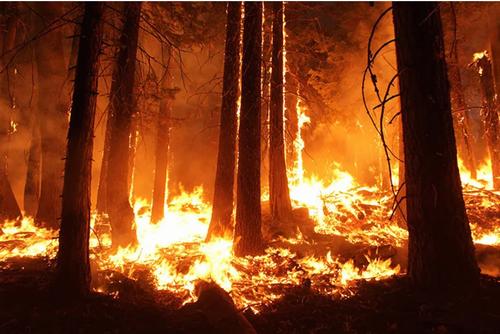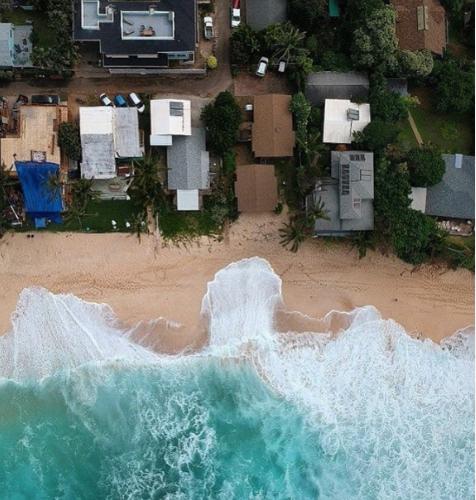
WASHINGTON, DC, July 6, 2024 (ENS) – Independence Day 2024 will go down in the record books as one of the hottest ever. In total, more than 100 million people – nearly one in every three Americans – spent Thursday under extreme heat alerts, according to the National Weather Service.
Downtown Sacramento, California’s capital city, reached a high temperature of 109 degrees on Thursday afternoon, one degree off the daily record of 110 degrees set in 1991. About 65 miles north of Sacramento, 28,000 people were forced to evacuate because of a raging wildfire that had grown to 3,568 acres and was only seven percent contained.
In Oklahoma, Tulsa thermometers registered 98 degrees on July 4, while Shreveport, Louisiana sizzled at 97 degrees. In Nevada, Las Vegas is forecast to hit 117 degrees on Sunday and 118 on Monday, July 7.
“Heat waves are occurring more often in major cities across the United States. Their frequency has steadily increased, from an average of two heat waves per year during the 1960s to six per year during the 2010s and 2020s,” according to data compiled by the U.S. Environmental Protection Agency for its new edition of “Climate change indicators in the United States,” released Tuesday.
“The average length of the heat wave season across the U.S. cities is 46 days longer now than it was in the 1960s and, in recent years, the average heat wave in major U.S. urban areas has lasted about four days,” the EPA indicator report states, as it documents the impacts of climate change on the people and environment of the United States.

An indicator represents the state or trend of certain environmental or societal conditions over a given area and a specified period of time. EPA’s indicators are designed to help the public understand observed long-term trends of the causes and effects of climate change. They provide evidence of what climate change actually looks like.
The EPA has published several summary reports of Climate Change Indicators in the United States, starting in 2010, then in 2012, 2014, 2016. Most recently, on July 2, 2024, the agency released the Fifth Edition of Climate Change Indicators in the United States.
EPA partners with 50+ data contributors from U.S. and international government agencies, academic institutions, and other organizations to compile these key indicators of climate change.
Within the United States, EPA works closely with the Centers for Disease Control and Prevention, CDC, National Aeronautics and Space Administration, NASA, National Oceanic and Atmospheric Administration, NOAA, U.S. Geological Survey, USGS, and the U.S. Department of Agricultur, USDA, and serves as a co-chair of the Interagency Indicators Workgroup under the U.S. Global Change Research Program, USGCRP.
“EPA’s Climate Change Indicators report is an authoritative resource of how the climate crisis is affecting every American right now and with increasing intensity,” said EPA Administrator Michael Regan.
“Extreme heat, flooding, and wildfires have become more common, harming human health, threatening livelihoods, and causing costly damage. Regular updates to the data in the Climate Indicators website and report help us track these unprecedented changes so we are better informed in our shared work to confront the crisis,” Regan said.
The report explores the interconnected nature of observed changes in climate. Chapters are thematically organized around: Greenhouse Gases, Heat on the Rise, Extreme Events, Water Resources at Risk, Changing Seasons, Ocean Impacts, Rising Seas, and Alaska’s Warming Climate.
The White House said in a statement July 2, that in addition to posing direct threats to lives and livelihoods, major weather events – which are becoming increasingly extreme due to the climate crisis – have had significant economic impacts.
“Last year’s record 28 individual billion-dollar extreme weather and climate disasters caused more than $90 billion in aggregate damage,” the White House stated.
“Meanwhile, many Republicans in Congress continue to deny the very existence of climate change and remain committed to repealing the President’s Inflation Reduction Act – the biggest climate protection bill ever – which would undermine the health and safety of their own constituents,” according to the White House.

As the impacts of drought, wildland fires, heat waves,flooding, and other extreme weather events intensify, President Biden is delivering the most ambitious climate agenda in American history – an agenda that is lowering energy costs for hardworking families, bolstering America’s energy security, creating thousands of good-paying jobs, and strengthening community-driven climate resilience across the country, the White House said.
New to the EPA’s Climate Change Indicators report this year are an indicator on Marine Heat Waves, showing trends related to multi-day high ocean temperatures, and an important section on Heat-Related Workplace Deaths.
Heat-Related Workplace Deaths Increasing
Heat is the leading cause of death among all hazardous weather conditions in the United States. During the 30 years from 1992 to 2022, a total of 986 workers across all industry sectors in the United States died from exposure to heat, finds the new EPA report.
During this time frame, 334 construction workers died due to heat exposure on the job, accounting for about 34 percent of all occupational heat-related deaths. Outdoor workers, particularly those engaging in strenuous physical activity, disproportionately face greater heat-related health threats, the EPA states
Since 1979, more than 14,000 Americans have died directly from heat-related causes, according to death certificates. The annual death rate is higher when accounting for deaths in which heat was reported as a contributing factor, including the interaction of heat and cardiovascular disease.
From 2001 to 2010, a total of about 28,000 heat-related hospitalizations were recorded across 20 states. Annual heat-related hospitalization rates ranged from fewer than one case per 100,000 people in some states to nearly four cases per 100,000 people in others.
People aged 65+ are a particular concern. This is a growing demographic group that is several times more likely to die from heat-related cardiovascular disease than the general population. Considerable year-to-year variability and certain limitations of the underlying data for this indicator make it difficult to determine whether the United States has experienced long-term trends in the number of deaths classified as “heat-related.”
People older than 65 accounted for more heat-related hospitalizations than any other age group from 2001 to 2010, and males were hospitalized for heat-related illnesses more than twice as often as females.

Thing are particularly difficult for people who work outdoors in Florida and Texas. In April Florida Governor Ron DeSantis, a Republican, signed into law a bill, which prevents local governments from requiring heat exposure protections for workers.
At present, there are no federal standards to protect outdoor workers in the United States from heat and humidity, which can be deadly.
On July 4, 2024 at 9:24 a.m. the National Weather Service issued a heat advisory for Central Florida with heat index values up to 110. “The combination of hot temperatures and high humidity will cause an increased risk of heat related illness today,” NWS said at the time.
Farmworker and labor advocates in Miami had spent years advocating for heat protections for outdoor workers and came close to victory before the agricultural industry successfully lobbied against the law.
Under the new law, which took effect July 1, it has been illegal for local governments in Florida to pass health and safety measures for outdoor workers in extreme heat. The decision comes after Florida experienced its hottest summer on record.

Texas Governor Greg Abbott, a Republican, was the first governor to pass such a law. In June 2023, Abbott approved a law that eliminates city and county ordinances like Austin’s and Dallas’ mandated water breaks – 10 minutes every four hours. It was a week when parts of Texas sweltered under triple-digit temperature, and weather officials urged everyone to stay cool and hydrated.
Texas is the state where the most workers die from high temperatures, government data shows. At least 42 workers died in Texas between 2011 and 2021 from environmental heat exposure, according to the U.S. Bureau of Labor Statistics. Workers’ unions claim this data does not fully reflect the magnitude of the problem because heat-related deaths are often recorded under a different primary cause of injury, the “Texas Tribune” newspaper reported.
Arizona is taking a more compassionate approach to dealing with extreme heat.
A historic new law in Phoenix, Arizona, will provide thousands of outdoor workers in the hottest city in the country with protections from extreme heat.
In a unanimous vote, the Phoenix City Council passed an ordinance requiring that workers have easy access to rest, potable water and shade, as well as training to recognize signs of heat stress, a statement from the National Council for Occupational Safety and Health said. The new ordinance applies to outdoor workers for city contractors and their subcontractors who provide construction, engineering, airport and other services to the city.
There has not been a U.S. national policy for addressing heat-related deaths at work, but that could be about to change.
On July 2, the Biden- Harris Department of Labor released a proposed rule https://www.osha.gov/heat-exposure/rulemaking with the goal of protecting millions of workers from the health risks of extreme heat. If finalized, the proposed rule would help protect 36 million workers in indoor and outdoor work settings and substantially reduce heat injuries, illnesses, and deaths in the workplace.

“Workers all over the country are passing out, suffering heat stroke and dying from heat exposure from just doing their jobs, and something must be done to protect them,” said Assistant Secretary for Occupational Safety and Health Douglas Parker. “Today’s proposal is an important next step in the process to receive public input to craft a ‘win-win’ final rule that protects workers while being practical and workable for employers.”
Under the OSHA proposal, employers would be required to provide training, have procedures to respond if a worker is experiencing signs and symptoms of a heat-related illness, and take immediate action to help a worker experiencing signs and symptoms of a heat emergency.
The public is encouraged to submit written comments on the rule once it is published in the Federal Register. The agency also anticipates a public hearing after the close of the written comment period. More information will be available on submitting comments when the rule is published. For more information on how to submit a comment on OSHA’s heat-exposure proposal, click here.
The Department of Labor continues to conduct heat-related inspections under its National Emphasis Program – Outdoor and Indoor Heat-Related Hazards, launched in 2022. The program inspects workplaces with the highest exposures to heat-related hazards proactively to prevent workers from suffering injury, illness or death needlessly. Since the launch, OSHA has conducted more than 5,000 federal heat-related inspections.
In addition, the agency is prioritizing programmed inspections in agricultural industries that employ temporary, nonimmigrant H-2A workers for seasonal labor. These workers face unique vulnerabilities, including potential language barriers, less control over their living and working conditions, and possible lack of acclimatization, and are at high risk of hazardous heat exposure.
President Joe Biden also announced on July 2 that later this summer, he will bring together state, local, Tribal, and Territorial leaders for a White House Summit on Extreme Heat.
Oceans Are Heating Up, Beaches Vanishing
Over the past century, sea surface temperature has increased and continues to rise. Sea surface temperature has been consistently higher during the past three decades than at any other time since reliable observations began in 1880, the EPA report states.
Marine heat waves have intensified. Between 1982 and 2023, the annual cumulative intensity of marine heat waves has increased in most coastal U.S. waters, with the largest changes in waters off the Northeastern Atlantic and Alaskan coasts. Marine heat waves are becoming either more common, longer, more intense, hotter, or some combination of these.
With warming ocean waters, many marine animals off U.S. coasts are shifting northward and moving to deeper waters. Since the 1980s, shifts have occurred among several economically important fish and shellfish species. For instance, American lobster, black sea bass, and red hake in the Northeast have moved northward by an average of 145 miles.
Coastal tidal flooding is becoming more frequent along the U.S. coastline. Most sites with long-term data have experienced an increase in tidal flooding since the 1950s. At more than half of these sites, floods are now at least five times more common than they were in the 1950s. The rate of increase of flood events per year is largest along the East and Gulf coasts, and at most locations in Hawai’i.

In response to the Paris Agreement, the Hawaiʻi State Government created the Hawaiʻi Climate Change Mitigation and Adaptation Commission, which states on its website https://climate.hawaii.gov/ that “13 miles of beaches around the state are already gone, including 10 percent of O‘ahu’s beaches because of coastal erosion. 70 percent of beaches around the state are currently threatened.”
“Since the 1960s, the number of annual flood days in the State has increased significantly. Our communities are at risk, and not just near the coast. Flooding is worsening further and further inland where seawater will flow backwards from storm drains – leading to pools of dirty, contaminated, brackish water where we live,” the Commission says.
The extent of area burned by wildfires in the United States has increased since the 1980s, with the largest increases occurring in the West and Southwest, the new EPA Climate Indicator report reveals.
Of the 10 years with the largest acreage burned, all have occurred since 2004, including peak years in 2015 and 2020. This period coincides with many of the warmest years on record nationwide.
Length of the Growing Season Is Growing
The average length of the growing season in the contiguous 48 states has increased by more than two weeks since the beginning of the 20th century. A particularly large and steady increase has occurred since the 1970s. States in the West, such as Washington and California, have seen the most dramatic increase.
In contrast, the growing season has become slightly shorter in Georgia. The observed changes reflect earlier spring warming as well as later arrival of fall frosts. The length of the growing season has increased more rapidly in the West than in the East.
Changes in the length of the growing season can have both positive and negative effects on the yield and prices of particular crops. Overall, warming is expected to have negative effects on yields of major crops, but crops in some individual locations may benefit, according to the Intergovernmental Panel on Climate Change report “Climate change 2022 – Impacts, adaptation and vulnerability.”
A longer growing season could allow farmers to diversify crops or have multiple harvests from the same plot of land. But it could also limit the types of crops grown, encourage invasive species or weed growth, or increase demand for irrigation.
A longer growing season could also disrupt the function and structure of a region’s ecosystems and could, for example, alter the range and types of animal species in the area.
Snowpack Season Is Shorter
From 1982 to 2023, the snowpack season became shorter at 80 percent of the sites measured. Across all sites, the length of the snowpack season decreased by an average of about 15 days and peak snowpack has shifted earlier by an average of nearly seven days since 1982.
Arctic Sea Ice Coverage Area Smaller
The September 2023 sea ice extent was the fifth smallest on record. It was about 789,000 square miles less than the historical 1981-2010 average for that month – a difference almost three times the size of Texas.
Since 1979, the length of the melt season for Arctic sea ice has grown by 37 days. On average, Arctic sea ice now starts melting seven days earlier and starts refreezing 30 days later than it has historically.
Read the report “U.S. Environmental Protection Agency. (2024). Climate change indicators in the United States” (Fifth ed., EPA 430-R-24-003)at: www.epa.gov/climate-indicators
Featured image: Farmworkers endure the increasingly hot temperatures, sometimes without water and shade breaks. Heat-related deaths are increasing among all outdoor workers in the United States. (Photo courtesy MedPage Today)
© 2024, Environment News Service. All rights reserved. Content may be quoted only with proper attribution and a direct link to the original article. Full reproduction is prohibited.



